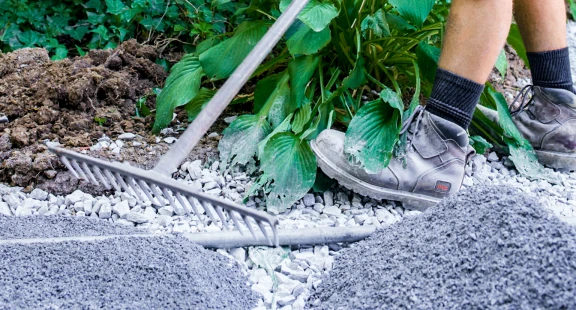Nothing is better than a vivid spring garden with blooms and lush foliage. Luckily, there are things you can do to keep your landscape good-looking even when the temperatures drop. With some excellent winter landscaping ideas, you can bring visual interest to your garden during the snowy season and elevate the typical winter landscape’s dark color palette.
Fall and winter landscaping ideas focus on more than just blooming plants. Instead, winter landscaping combines ornamental plants, decorations, intelligent plant layouts, berries, bark, and snow.
The article explores the most attractive landscaping ideas for winter to keep your outdoors beautiful and inviting year-round.
#1 Incorporate Evergreen Plants
One classical front yard landscaping idea for winter includes planting evergreen trees and shrubs for structure and color.
Some evergreen plants are also easy to maintain and have excellent pest and disease resistance, offering additional benefits for gardeners.
Popular options for evergreen plants are:
- Pine
- Holly
- Spruce
- Fir
- Boxwood
There are several ways to incorporate evergreens in winter landscape design. With careful positioning, you can highlight focal points or improve the functionality of your backyard despite the season.
Use potted plants to frame entrances or plant them directly around pathways to create structure. Also, taller evergreens are excellent privacy screens and green segments in the winter.
#2 Add Winter-Blooming Plants
Even though many species go dormant in the winter, you still have a wide range of winter-blooming trees, plants, and shrubs to add a splash of color to your landscape:
- Winter Jasmine
- Camellia
- Viburnum
- Mahonia
- Violas
- Snowdrops
- Witch hazel
Because these winter-blooming plants are early food sources with bright colors and fragrant blooms, they attract pollinators and are colorful additions to your garden.
#3 Incorporate Ornamental Grasses
Even beginners in landscaping can go right with ornamental grasses. They add texture, color, movement, and interest to every landscape year-round. However, several varieties are beautiful during winter, creating a mesmerizing contrast with the winter landscape.
Those include:
- Miscanthus
- Feather reed grass
- Switchgrass
- Foxtail millet
- Blue fescue
Additional benefits of planting ornamental grasses include their simple maintenance and flexibility. You can use them as:
- Focal points
- Texture increasing elements
- Backdrop
- Plants to soften edges of hardscape elements
#4 Hardscaping for Winter Appeal
If you lack winter landscape ideas, think outside the box and incorporate hardscape elements into your winter garden.
You can enhance your existing hardscape elements with materials that will preserve their appearance in frost and low temperatures. In addition, if you pick warm brick or colorful natural stone options, you can add color to dull landscapes.
Additionally, consider building hardscapes to add warmth and create a more inviting outdoor space:
- Fire pits
- Outdoor fireplaces
- Benches
- Stone walls
Some hardscaping elements, such as benches, look more beautiful when covered with snow.
#5 Outdoor Lighting
December landscape doesn’t have to include only holiday decorations. You can experiment with lighting to adjust the ambiance and increase safety during winter when it is dark outside from 6 pm.
You can opt for traditional lighting fixtures or solar-powered lights as a more eco-friendly option.
Here are a few tips on how to incorporate lighting to elevate your backyard landscaping for winter:
- Use string lights or spotlights on evergreen plants to highlight them
- Experiment with low-voltage lighting to accentuate snow-covered architectural elements
- Illuminate walkways and patios
- Use spotlights to draw attention to water features and winter-blooming plants.
#6 Winter Container Gardens
Container gardens work well year-round and are one of the secrets of successful landscaping in the winter. Create a stunning display with hardy plants and a combination of evergreens. Customize your container gardens with winter-themed twigs, pinecones, bark, reindeer, snowflakes, and other decorations.
Some of the cold-tolerant plants to consider for your containers are:
- Pansies
- Heather
- Cyclamen
- Dwarf conifers
- Bay laurel
- Holly
- Violas
#7 Add Color with Winter Décor
Winter is a great season to play with seasonal decorations and create a festive atmosphere. Here is what you can do in the winter to create a lovely landscape only with decoration:
- To decorate the garden, use traditional winter wreaths with pinecones, berries, and ribbons.
- Hang twigs garlands decorated with fried flowers on your porch
- Add character with bird feeders
- Stack logs to create a warmth atmosphere
- Add a whimsical touch with snowglobes
You can make most of the seasonal winter decorations from twigs, pinecones, and things you already have in your backyard.
#8 Install Bird Feeders and Wildlife-Friendly Features
Winter landscapes don’t have to be static. Instead, bring movement and life with bird feeders, birdbaths, and wildlife plants.
These are essential ways to provide wildlife food during winter months. Focus on diversity and keep your feeders clean and filled all the time.
Planting shrubs such as crabapple and winterberry holly is a way to give wildlife food and shelter in the winter. At the same time, your landscape will get a delightful dimension.
#9 Winter-Friendly Water Features
As part of winter backyard ideas, water features help create splendid winter scenery. Focus on winter-friendly features, including ponds, fountains, and waterfalls. These features will become unique ice elements when they freeze, adding additional decoration to your winter front yard landscaping process.
However, to avoid freezing, try a pond or fountain heater to keep the water running year-round. You can experiment with different heater styles, including submersible heaters. In addition, some winter-friendly water features come with de-icing systems to prevent ice build-up.
#10 Mulch and Ground Cover for Insulation
Outdoor landscaping also includes preserving plants’ health during colder months and preparing them for the growing season. As a standard practice in exterior landscaping, mulching protects plants by providing root insulation.
In addition, fresh layers of mulch enhance the garden’s appearance by providing a polished look to the garden beds. Here are mulch materials to consider for winter:
- Organic mulch – bark, wood chips, leaves, straw
- Rocks
- Rubber mulch
#11 Seasonal Color with Berries and Bark
Focusing on plants with colorful for winter landscapes has several benefits:
- They are a food source for wildlife
- Berries bring color and texture to dull winter gardens
- Berries are easy to maintain but highly rewarding
- Many plants have berries that persist through the entire winter
- Popular plants with berries are hollies, pyracantha, and hollies.
The alternative to berries or an additional way to spruce up a garden in the winter is plant species with attractive bark. That way, once the flowering season is over and the foliage falls over, your plants will remain attractive because of their bark.
For example, paperbark maple and birch trees are known for their attractive bark.
#12 Using Snow as a Design Element
If you live in a climate prone to snow, use it to highlight some aspects of your landscape. Moreover, some architectural details, such as statues and arches, look even more stunning when covered with snow.
In addition, you can create picturesque, fairy-tale scenery with strategically planted evergreen trees. Add a string of Christmas lights, and you’ve got a traditional yet elegant holiday ambiance.
#13 Raised Beds and Garden Structures
You’ll appreciate ideas for landscaping in winter, which focus more on the garden structures and raised beds. When you have pergolas or arbors in the garden, you’ll bring visual interest despite the weather and season.
Also, even though dormant in winter, evergreen winter creeper and Trumpet vine look attractive with appropriate supporting structures.
Experiment with:
- Arbors
- Lattice panels
- Obelisks
- Custom-made trellises
#14 Plan for Spring During Winter
Taking care of your outdoor space with plants and hardscape features requires commitment year-round. But, if you start thinking about the growing season and plant requirements for spring during winter, you’ve done half of the work.
For example, plan and create a stunning layout for your spring garden by planting the early bulbs in the fall. Crocuses and daffodils bloom in early spring, giving a burst of color after grey winter months. The alternative to early bulbs is forsythia and azaleas, as early flowering shrubs.
Conclusion
Winter landscapes can look sensational with a few additions and creative landscaping ideas. A few ideas to try this winter include:
- Decorating the garden with wreaths, pinecones, and twigs
- Planting evergreen and winter-blooming species with structures such as trellises and pergolas
- Mulching for protection and tidy looks
- Highlight garden focal points with lights
- Using berries and birdfeeders for decoration and wildlife
- Focusing on hardscapes and water features instead of foliage and blooms
In addition, you can combine several ideas to find out what works best for your winter landscape.
FAQ
How can you make a winter garden more colorful and attractive on a budget?
Use winter-blooming plants, evergreen trees, and shrubs to add color to your winter landscape. To decorate your space, engage in DIY projects with twigs, dried flowers, and pinecones.
How can I attract wildlife to my garden in winter?
Install non-freezing water features and birdfeeders to attract wildlife during winter. You can also plant shrubs with berries as an additional food source.
What plants are best for winter landscapes in colder climates with plenty of snow and frost?
Conifers and deciduous shrubs, such as azaleas and winter-hardy varieties of Rhododendrons, look beautiful under snow and can remain healthy and thrive under colder temperatures.
What are some trendy landscaping ideas for winter?
Hardscaping with unique elements and modern materials is the trend for winter 2024/25. As part of the evolving outdoor living trends, interactive features, such as fire pits and outdoor kitchens, are popular this season.
Plant-related trends focus on planting native, winter-blooming plants and ground covers for color and texture.

